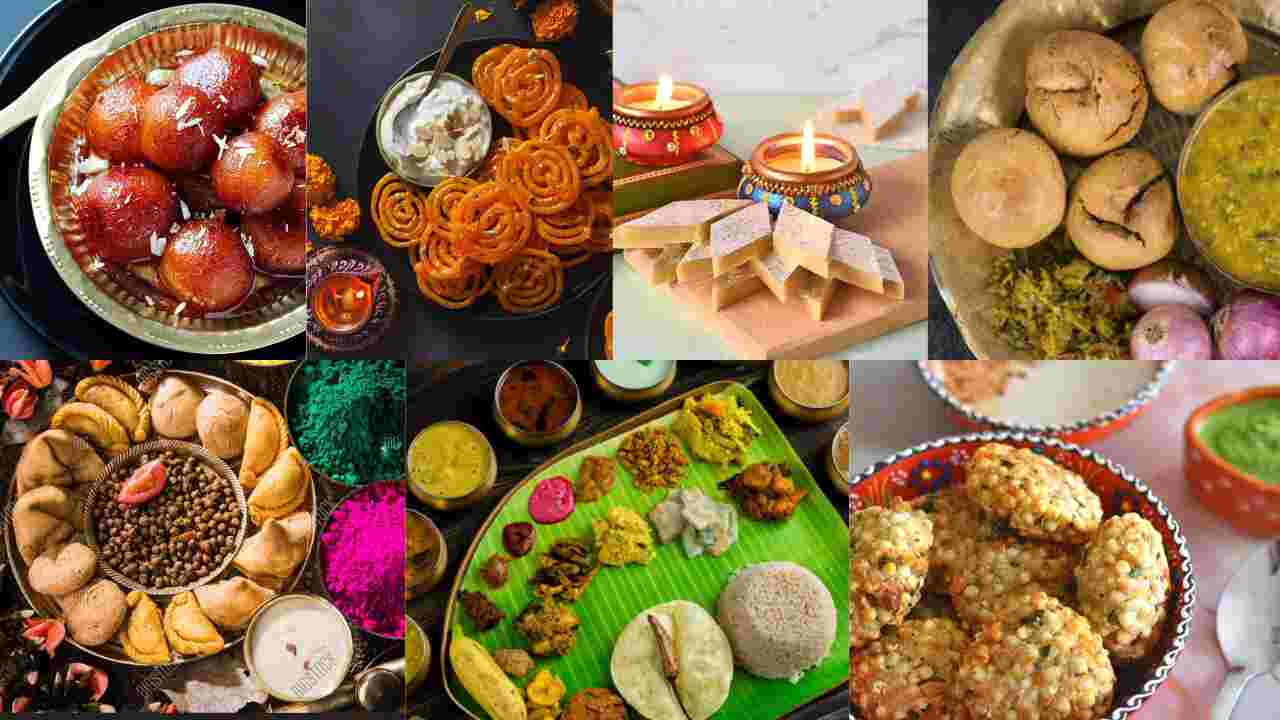With the exploration of festival traditions in India begins – herein lies the spirit of celebration and a myriad variety of different delicacies. From the saccharine of Diwali’s Gulab Jamun to Makar Sankranti and its heavy, rich dishes, every festival enfolds gastronomy. Come along with us as we explore the cultural relevance of these heavenly treats, complementing the colorful mosaic of Indian celebrations.
Setting off on a culinary tour of India’s festivals opens up a vast array of different tastes. In the North, South, East as well as West, every region celebrates traditionally, enriching cultural diversity and the spirit of festivity.
Let’s explore India’s Festive Flavors.
North India’s Festive Flavors:
Diwali
- Gulab Jamun: These deep-fried milk dumplings are covered with sugar syrup and they represent festival happiness.
- Jalebi: Deep-fried spiral-shaped batter soaked in saffron-flavored syrup coated with sugar, signifying the vibrant colors of Diwali.
- Kaju Katli: Diamond-shaped cashew fudge – a symbol of wealth and success.
Holi:
- Thandai: Spiced milk drink with almonds, saffron, and poppy seeds which was believed to cool down the body during the energetic festivities.
- Samosas: Triangular pastries stuffed with spiced potatoes or lentils, enjoyed during Holi occasions.
- Chaat: A delicious street snack combining crunchy deep-fried dough, potatoes, and chickpeas with spicy chutneys.
South India’s Festive Flavors:
Pongal/Makar Sankranti:
- Pongal: A tasty curry of rice and lentils prepared with ghee, black pepper, and cumin to represent a bountiful harvest.
- Sakkarai Pongal: A sweet version of Pongal made with jaggery, rice, and lentils, representing sweetness and prosperity.
Onam:
- Onam Sadya: A sumptuous banana leaf meal that includes dishes such as Avial (a vegetable curry), Thoran (stir-fried vegetables) and Payasam( sweet rice pudding ) signifying unity and plenty.
East India’s Festive Flavors:
Durga Puja:
- Rasgulla: Soft steamed cheese dumplings soaked in sugar syrup, to kick start the process of celebration.
- Sandesh: A pure Bengali sweet that is prepared using fresh paneer and garnished with cardamom or saffron, symbolizing purity.
Bihu:
- Pitha: The handmade traditional rice flour cakes in different shapes and filled with jaggery, coconut & sesame, speaking about the bountiful of agriculture.
- Laru: Sweet sesame balls made during Bihu symbolize the season of harvest.
West India’s Festive Flavors:
Ganesh Chaturthi:
- Modak: Steamed or fried dumplings filled with a mixture of coconut and jaggery, representing the sweet offering to Lord Ganesha.
- Puran Poli: Sweet lentil stuffing between layers of flatbread to represent the season’s joyfulness.
Navratri:
- Fafda: A crispy snack made of gram flour and usually eaten with Jalebi during Navratri festivals.
- Sabudana Khichdi: Tapioca pearls cooked with potatoes, peanuts, and spices, commonly consumed during fasting.
Central India’s Festive Flavors:
Teej:
- Ghewar: A disc-shaped sweet deep-fried and soaked in sugar syrup, associated with Teej celebrations.
- Malpua: Sweet pancakes served with rabri (sweetened condensed milk), symbolizing indulgence and festivity.
Khajuraho Dance Festival:
- Dal Bafla: Wheat cakes served with dal (lentils), ghee, and chutney, showcasing the regional flavors.
- Bundeli Kalaadi: Local cheese, often used in savory snacks during cultural events.
Conclusion:
These dishes not only reflect the variety, and uniqueness of each region but also have cultural, religious, and symbolic importance in the light of these festivals. They represent the culinary manifestation of the wealth of traditions and values that are present during each celebration, providing a synesthetic and communal interaction to those who partake in the celebration.
